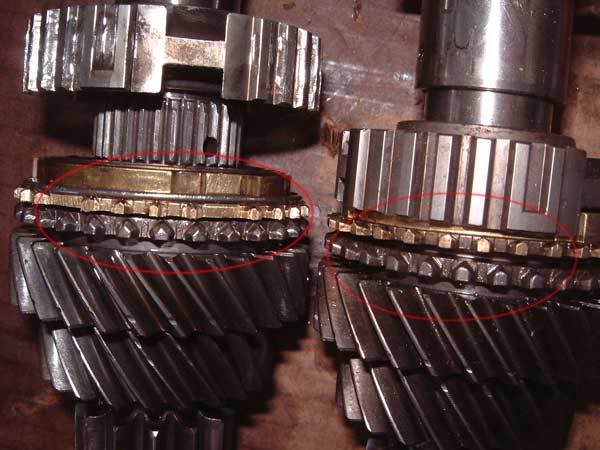As an Amazon Associate, I earn from qualifying purchases at no extra cost to you.
What are the Symptoms of Bad Synchros?
The symptoms of bad synchros include grinding or clunking noises when shifting gears and difficulty shifting into or out of gear. These symptoms may indicate that the synchronizers in the transmission are worn or damaged, leading to synchronization issues between the gears.
When left unaddressed, bad synchros can cause further damage to the transmission and result in costly repairs. Bad synchros can be a frustrating and potentially dangerous issue for drivers, as it can lead to difficulties in smoothly changing gears and can ultimately affect the overall performance of the vehicle.
Understanding the symptoms of bad synchros is essential for timely diagnosis and repair to maintain the functionality and safety of the transmission system. We will explore the key symptoms of bad synchros and their potential impact on vehicle performance.

Credit: www.jackstransmissions.com
Common Symptoms
Bad synchros in a vehicle can manifest through various common symptoms. These indicators can help drivers identify potential issues with their transmission system.
Difficulty Shifting Gears
One symptoms involve difficulty shifting gears where the gears grind or crunch during the process.
Grinding Or Crunching Noises
Another common symptom is the presence of grinding or crunching noises while attempting to shift gears.
Resistance Or Stiffness
Resistance or stiffness in the gear shifts can indicate potential issues with the synchros.
Causes Of Bad Synchros
When your vehicle’s synchros start to fail, it can cause a range of issues such as difficulty shifting gears, grinding noises, and even gear slippage. Understanding the causes of bad synchros can help you identify the problem early and prevent further damage.
Worn Or Damaged Teeth
Synchros can wear down over time due to constant friction and stress during gear changes. This results in the gears not synchronizing properly, leading to difficulty shifting and grinding noises.
Lack Of Lubrication
Insufficient lubrication can lead to increased friction between the synchros and the gears. This can cause the synchros to wear out more quickly and result in rough shifting and grinding sensations.
Incorrect Gearshift Technique
Using excessive force or speed when shifting gears can put extra strain on the synchros, causing accelerated wear and eventual failure. Unnecessarily harsh gear changes can also lead to synchro damage over time.
Also Read: What Does a Bad U-Joint Sound Like?
Diagnosing Bad Synchros
When it comes to diagnosing bad synchros, it’s crucial to be aware of the symptoms and signals that indicate potential issues with your transmission system. The synchronization of gears is vital for smooth gear shifting, and any problems with the synchros can result in various noticeable signs. Understanding the symptoms of bad synchros is essential in order to address the issue promptly and prevent further damage to your vehicle.
Testing For Gearshift Issues
One way to diagnose bad synchros is by testing for gearshift issues. Are you experiencing difficulty shifting gears, or do you hear grinding or crunching noises when shifting? These are common indications of synchro problems. Pay attention to any resistance or roughness when engaging the clutch or when trying to shift into different gears. These symptoms may point to synchronization issues that require attention.
Transmission Fluid Inspection
Another method to diagnose bad synchros is through transmission fluid inspection. Check the condition and level of your transmission fluid regularly. Look for any signs of metal shavings or debris in the fluid, as these could be indicative of synchro wear and tear. Additionally, observe the color and smell of the fluid. If it appears dark or has a burnt smell, it could signal internal transmission problems, including potential issues with the synchros.
Seeking Professional Help
If you observe any of the aforementioned symptoms or suspect problems with your synchros, it’s important to seek professional help. Consult a qualified mechanic or transmission specialist to conduct a thorough diagnosis and assessment of your transmission system. They can perform more in-depth tests and inspections to accurately identify any issues with the synchros and provide appropriate solutions to address the problem.

Credit: eeuroparts.com
See Also: Is Pressure Washing Cars Good Or Bad?
Preventing Synchro Problems
Regular Maintenance
Regular maintenance plays a crucial role in preventing synchro problems. Ensure transmission fluid gets changed on schedule to prevent premature wear & tear.
Proper Gearshift Technique
Adopting the proper gearshift technique is essential to keeping synchros healthy. Avoid forcing the gear lever into place to prevent damage.

Credit: www.hondacivicforum.com
Conclusion
Ultimately, recognizing the symptoms of bad synchros is crucial for maintaining the health of your vehicle. Addressing issues promptly can prevent costly repairs and ensure smooth gear shifting. If you notice grinding noises or difficulty shifting gears, it’s wise to consult a professional mechanic for a thorough inspection.
Stay proactive to keep your car running smoothly.


